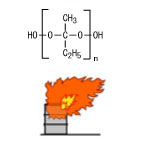| Case Name |
Ignition caused due to contamination of impurities during storage of methyl ethyl ketone peroxide |
| Pictograph |

|
| Date |
June 15, 1983 |
| Place |
Osaka, Osaka, Japan |
| Location |
Electrical equipment factory |
| Overview |
An explosion occurred while residual methyl ethyl ketone pixel oxide (MEKPO) was kept at a electric parts production factory. The curing operation of polyester resin had been completed, the residue of MEKPO used as a curing agent was collected, and it was kept it in a hazardous materials warehouse. The explosion occurred in the warehouse for hazardous materials, and a fire broke out. It is estimated that impurities contaminated the collected MEKPO, which ignited and exploded. Recognition of the hazardous nature of organic peroxide was lacking. Adjacent inhabitants and public fire fighters carried out fire fighting activities. |
| Incident |
An explosion and fire occurred at a factory manufacturing electric parts where organic peroxide was kept. The residue of MEKPO used as a curing agent for curing polyester resin was collected and stored in a warehouse for hazardous materials. The explosion occurred during storage.
MEKPO: Abbreviation of methyl ethyl ketone peroxide which is organic peroxide. |
| Processing |
Storage |
| Substance |
Methyl ethyl ketone peroxide, Fig2 |
| Unsaturated polyester resin |
| Type of Accident |
Explosion, fire |
| Sequence |
MEKPO was subdivided for curing polyester and taken out. The remaining MEKPO was recovered after work. Recovered MEKPO was kept in the warehouse. The explosion occurred five hours later. |
| Cause |
It is presumed that MEKPO reacted with polyester resin which contaminated as an impurity and ignite. The contamination occurred in the process of subdivision, use for the curing and recovery of the remains. |
| Response |
No emergency measures were taken in the workplace.
Adjacent residents carried out fire fighting activities for initial extinguishing using a bucket. Finally, the fire was extinguished by the public fire brigade. |
| Countermeasures |
The amount of organic peroxide used is appropriately managed, and only the necessary amount each day is brought to the workplace. The recovered amount after work is minimal. Measures should be taken to prevent impurities from entering the container of organic peroxide. |
| Knowledge Comment |
As organic peroxide is highly reactive, close attention is necessary for not only temperature control but also mixing of impurities. |
| Background |
The management of chemicals was insufficient due to a lack of recognition of the hazards of organic peroxide. The workers did not take measures against the contamination by a foreign material. |
| Reason for Adding to DB |
Example of fire of organic peroxide caused due to contamination of impurities |
| Scenario |
| Primary Scenario
|
Organizational Problems, Inflexible Management Structure, Insufficient Education, Poor Value Perception, Poor Safety Awareness, Inadequate Risk Recognition, Ignorance, Insufficient Knowledge, Insufficient Study of Danger of Treating Material, Planning and Design, Poor Planning, Poor Quantity Control, Regular Movement, Careless Movement, Contamination under Unconsciousness, Bad Event, Chemical Phenomenon, Spontaneous Ignition, Secondary Damage, External Damage, Explosion/Fire
|
|
| Sources |
Fire and Disaster Management Agency, Fire caused by the contamination of chemicals. Examples of accidents at hazardous materials manufacturers, pp. 86-87 (.1983)
|
| Physical Damage |
Part of a concrete block one-story warehouse (for hazardous materials) was damaged by fire. A vinyl chloride plate was damaged by fire. |
| Financial Cost |
¥ 100,000 (Fire and Disaster Management Agency). |
| Multimedia Files |
Fig2.Chemical formula
|
| Field |
Chemicals and Plants
|
| Author |
OGAWA, Terushige (Graduate School of Environment and Information Sciences, Yokohama National University)
TAMURA, Masamitsu (Center for Risk Management and Safety Sciences, Yokohama National University)
|